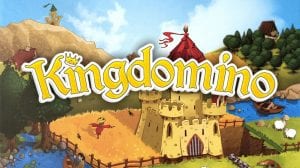Disclosure: Meeple Mountain received a free copy of this product in exchange for an honest, unbiased review. This review is not intended to be an endorsement.
If you’re a YouTube fan then you just might have heard of The Holderness Family. Internet famous for their X-Mas Jammies song and general craziness, the Holderness Family are a bubbly couple with two children and apparently a LOT of free time. Their YouTube channel videos are full of fun, laughter, singing, and lots of zany antics.
When my wife mentioned they were doing a campaign for a board game on Kickstarter, I’ll admit I was skeptical. After checking out the Kickstarter video for Family Showdown, I was intrigued enough to reach out to them and request a review copy. Let’s dive in and see if this game is full of fun…or a flop!
Family Showdown Overview
Family Showdown is an old school style board game in that it has a single track to victory and a spinner. Players will compete in teams to accomplish various challenges and advance on the victory track. Players can either choose to play the complete game (approx 30-45 minutes) or a shorter version of the game (20-30 minutes) by taking the “short attention span” path. The first team to reach the end and win a final showdown wins the game.
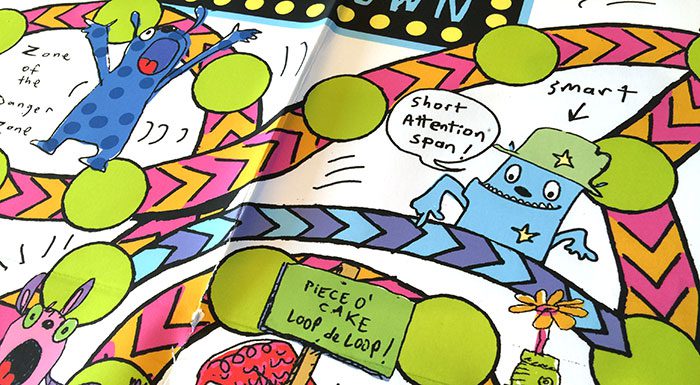
How to Set Up Family Showdown
Players divide up into 2-4 teams of at least two people. In our experience, having more players on your team is simply more fun. If you’re playing with younger kids, split them up evenly. Shuffle the 4 decks of cards (Fetch, Blobblobblob, Do What?, and Showdown) and place them within reach of players. Each team takes a pawn and places it on the start space. Decide which team will go first by performing a showdown from the top of the Showdown deck. The winner of the Showdown moves forward and the game continues in clockwise order.
How to Play Family Showdown
In Family Showdown players advance along the victory track by drawing cards and completing challenges that are randomly selected with the spinner.

Three of the challenges (Fetch, Do What?, and BlobBlobBlob) are only performed by the current team, while the final challenge (Showdown) is performed by both teams simultaneously. Since the challenge cards are the heart of the game, let’s look them over.
Fetch
In the Fetch challenge the current team performs a scavenger hunt throughout their house. One person from the team will turn over cards from the top of the stack and call out the text. One other player will run around the house locating that item, touching it, and yelling out what they found. This continues until the timer expires. Then the team moves forward one space for every correctly identified card
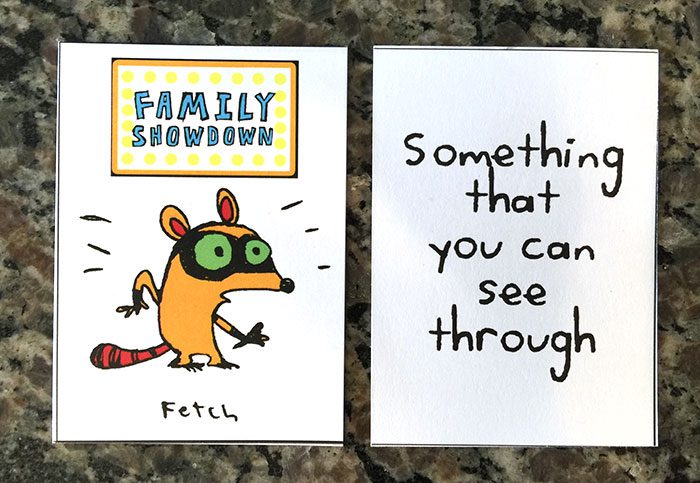
Blobblobblob
In the BlobBlobBlob challenge the current team will sing a song using only the words “blah”. One member of the team draws cards off the top of the deck, looks at the song title, and sings that song to their team. This continues until the timer expires. Then the team moves forward one space for every correctly identified card.

Do What?
In the Do What? challenge the current team will act out traditional charades. One member of the team will be drawing cards from the top of the deck, then acting out the phrase on the card to their team. When the timer expires the current team moves forward one space for every correctly identified card.
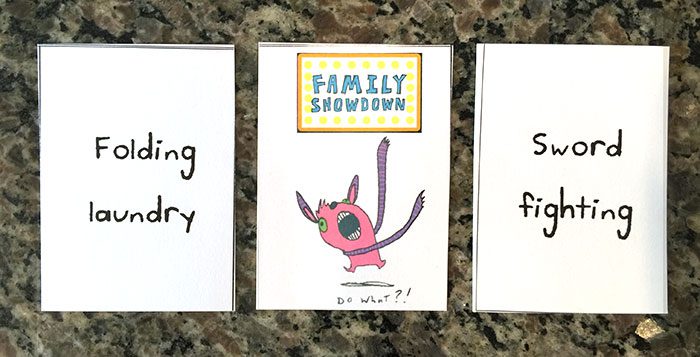
Showdown
In the Showdown challenge both teams participate simultaneously. A single card is drawn from the top card from the stack, players flip the timer, then both teams work to accomplish the challenge. Showdown cards are split into Physical and Mental challenges. Physical challenges are tasks like hopping on one foot, spinning around, doing pushups, etc. Mental challenges require teams to take turns calling out one answer to the challenge until a team can’t think of an answer. The winning team moves forward 3 spaces.
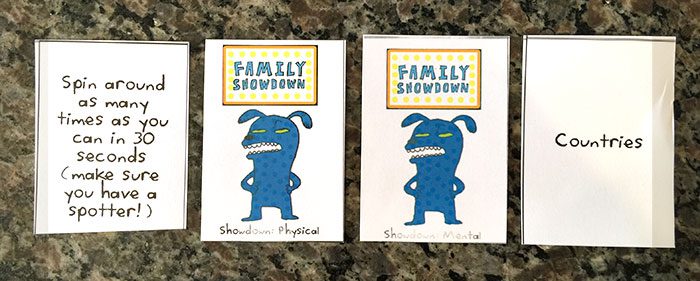
Winning Family Showdown
In order to win, teams must first make it to the Challenge Spot. Each subsequent turn that team must initiate a Showdown. If you win a Showdown while in the Challenge Spot, your team wins the game!

What I Like About Family Showdown
The best thing about Family Showdown is that when my entire family to plays we all have a blast. There are very few games out there that can genuinely make my kids jump up and down with excitement because they want to play it. Family Showdown does that by making kids feel like full participating members of the process. They get to yell and shout and be silly. They get to run around the house, like mad, racing to find an item. They can sing (usually at the top of their lungs) the word BLAH to the tune of “Let It Go”.
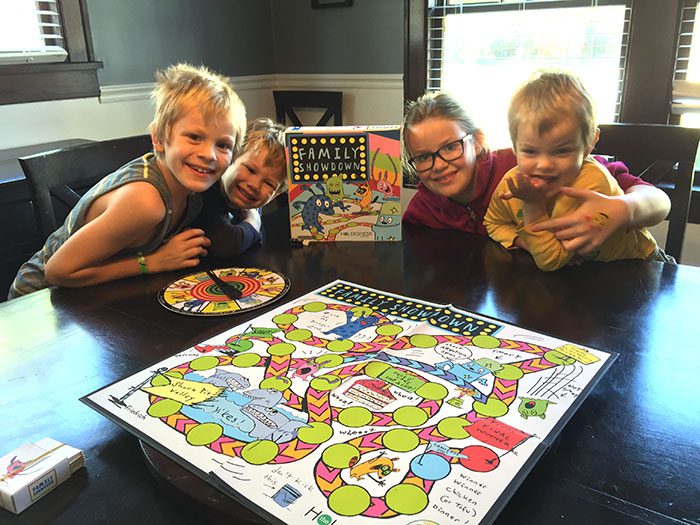
The challenge cards are well thought out, and varied. There’s a good mix of movement and thinking. Watching my 8 year old son acting out “folding laundry” was a hoot…because he’s NEVER DONE IT BEFORE! But we still guessed it correctly. Listening to my wife sing the tune to Gangnam Style with only the word BLAH was enlightening. Is there a person on the planet who hasn’t heard that song at least twice?
The art is great. It’s whimsical, large, bright and colorful. The gameplay is interesting. Rather than using a spinner and mapping it directly to movement, it’s used to select the challenge. Your movement on the board is tied directly to how well your team does. This offers a good catch up mechanism. Throw in the Showdown challenges and that means one team is never guaranteed a win.
My wife and I also had a great time playing it with them. At one point she got the Fetch card “things that can be scratched” and promptly chased our dog around the house yelling “Duncan’s butt!” As you might expect, our kids thought that was hilarious.
What I Dislike About Family Showdown
Some of the cards in each stack (primarily BlobBlobBlob and Do What?) are going to be a challenge for younger kids (and even some adults). In an effort to be timely, Kim and Penn have added songs they know NOW. That’s great for playing this game over the next year or two, but not so great for playing this game in 5 years when no one remembers “Watch Me (Whip/Nae Nae)”. Fortunately those things are easy fixes. My suggestion was to come up with most of the cards to be appropriate to a younger audience and mark cards appropriate for older kids and adults. That way they can be easily pulled out.
The “Cell Phone Jail” box is far too large for the game in it’s current format. This is likely because of it’s prototype status.
A few of the rules in the book were too vague, or permissive. “Players can choose as a group to allow players to pass. This is how we play it in our family, but you can choose.” I suggested to The Holderness Family that they simplify the rule to “Players may pass if necessary.” Much simpler, and with no ambiguity.
The game as designed has mental and physical Showdown cards in different stacks. I suggested that the two stacks be combined. This avoids confusion, simplifies setup, and leaves more room on the table.
Final Thoughts on Family Showdown
Family Showdown is a throwback to classic family games like Charades, Candy Land, and Chutes and Ladders while still being more than any of them. It’s a super fun, loony game for friends and family. It plays fast, it gets people up and moving, but still engages you mentally. Not many games can say that
First time designers Kim and Penn Holderness have made a genuinely fun game. They’ve put time, thought, effort, and money into creating the sort of game that THEY wanted to play, and they took a chance that others might want the same thing. Family Showdown has already reached their target funding goal with 9 days still remaining on the Kickstarter. That means it’s going to be made! If you’re looking for a fun board game that you can play with your kids, or a silly game to play with your friends at the end of a long night of hardcore gaming, then look no further. Fans of silly games like Rhino Hero, Go Cuckoo, Dancing Eggs, Ca$h ‘n’ Gun$, Pie Face, Loopin’ Louie, and Hedbandz will probably enjoy this one.
Do yourself a favor and check out Family Showdown!
- Designer: Kim & Penn Holderness
- Artists: Paul Friedrich
- Release Date: 2017
- Player count: 2-4 (teams)
- Age range: 8+
- Time range: 20-45 minutes
- Mechanism(s): Teams, Memory, Physical Movement, Charades




